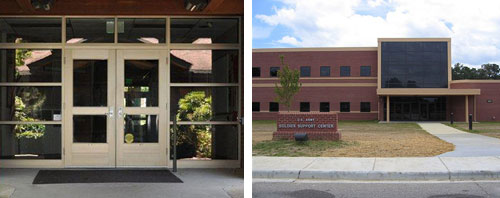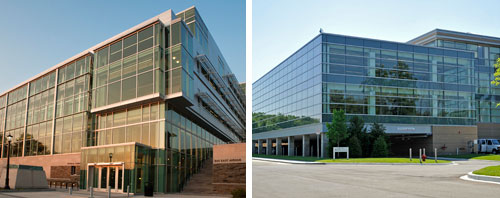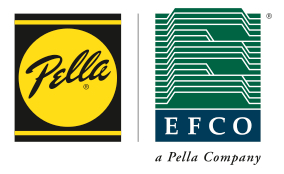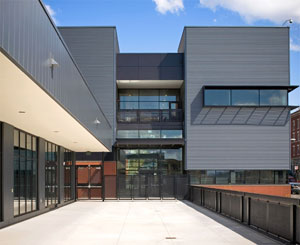Window and Fenestration Systems Selection
STOREFRONT SYSTEMS
Storefront systems take their name from retail settings, where they are commonly used for large, single floor height openings of glass. These systems were designed for light commercial single story retail viewing and readily incorporate entrances for quick access to interior product displays. They are often used on interior applications such as shopping malls or schools as well as exterior light commercial applications. They typically span a floor-to-floor or a floor-to-head condition without passing in front of any intermediate anchorage conditions.
 |
Aluminum Storefront system The photo on the left shows a typical lower level storefront solution while the photo on the right shows an appropriate upper level use of storefront. Left building: Canyon Creek Elementary School Right building: Fort Lee Soldier Support Center Photos courtesy of EFCO, a Pella Company |
Storefront system strengths include convenience for contractors who normally have access to multiple local suppler/installers who are able to shop fabricate a system within a relatively short lead time. Field installation of these systems is commonly done with a dry gasket system which means that fabrication is readily available and subsequent re-glazing or replacement is easy. In terms of cost, these systems are typically the least expensive when compared to curtain walls or pre-glazed aluminum window systems. However, storefront systems are restricted to a single floor installation since there are very limited provisions for a supplemental structure within the frames. From a design standpoint, they also offer limited customization of mullions and accessories, limited anchorage options, and limited opening configurations.
Storefront systems are best suited for low-rise applications typically on the ground floor. However, they may be used on upper floors as long as the code and environmental conditions don’t require higher structural and/or water management performance than is possible with these inherently limited systems. Storefront systems are not intended to be stacked directly on top of each other and should not be used in upper stories of mid to high rise buildings since they are not rated for higher winds that may be present there. Storefront systems are also quite appropriately used for interior applications such as shopping malls, schools, etc. where simple separation of conditioned space is sought.
| Aluminum Storefront System Case Study Fire Station #10 Location: Seattle, WA |
||
Project Category: Other Government Service |
CURTAIN WALL SYSTEMS
A curtain wall system is a complete exterior envelope facade system which provides a non-structural, relatively lightweight, weather-tight covering on buildings. In the case of small, low-rise projects, the system may be field fabricated or “stick built” and glazed using standard components similar to a storefront system. However, curtain wall components are notably different in design and performance characteristics with typically much better results compared to storefront components. Larger projects may justify full factory fabrication with panels prepared and glazed ready to be placed directly onto the building structure. Curtain wall systems are generally installed outside of the structural system of a building running past floor slabs and other structural elements. They are then attached via tiebacks directly to the building structure at floors, columns and beams. This installation process means that all wind loads and dead loads imposed on the system are compartmentalized and transferred directly to the building structure. Hence the curtain wall system carries only its own weight and loading while the building structure absorbs all imposed loads.
 |
Aluminum Curtain Wall system This system is best suited to multi-story applications with a variety of performance requirements. Left building: Cornell Physical Science Building Right building: Greenpath Photos courtesy of EFCO, a Pella Company |
The strength of curtain wall systems lies in its higher overall performance, particularly when compared to a storefront system. This is true in terms of wind resistance, water management, and thermal performance. From a design standpoint they are easy to customize, are available with a variety of interior and exterior aesthetic appearances, and allow a virtually unlimited range of installation locations, configurations, and opportunities. Typically product design and fabrication comes from a single source meaning that specific decisions can be made early related to anchoring options, accommodation of specified glazing thickness, and other details. Most curtain wall manufacturers also offer accessory items such as sun shades or light shelves to enhance day lighting approaches for the overall building. From a building operation standpoint, it should be noted that many curtain wall systems use dry gasket systems which allows for simplified re-glazing should it be needed for any reason in the future.
Proper scheduling and planning are required to allow for the production and delivery of curtain wall systems. Certain standardized systems are readily available, but with greater customization often comes greater lead times that need to be allowed for. Beyond the schedule, the cost of curtain wall systems is often cited as higher than other systems. However, that should be reasonably expected considering the higher quality and higher performance that is usually included in curtain walls. In some cases it may be worth doing a life-cycle analysis on the system compared to less expensive systems to identify potentially higher long term costs for maintenance, repairs, and replacement, not to mention higher potential building energy costs compared with poorer performing systems.
Site fabricated curtain wall systems are best suited for low-rise to mid-rise buildings where overall performance exceeds the capabilities of storefront. Unitized curtain wall systems are best suited for most mid-rise to high-rise applications that have repetition in unit sizes and require superior performance. They are also well suited to situations where customization of the system itself is desired.
| Aluminum Curtain Wall Systems Case Study University of Wisconsin, Hyland Hall Location: Whitewater, Wisconsin |
||
Project Category: Schools and Colleges |
CONCLUSION
Every building deserves to have the most appropriate fenestration solution designed and specified into it. It is up to the architect to determine the full extent of what is or is not most appropriate on a building to building basis. By understanding the attributes of individual manufactured window units, storefront systems and curtain wall systems, the best match can be determined. In the end that selection will impact the overall design, the performance of the building, and the long term sustainability and usability of a newly created or renovated portion of the built environment.

|
With Pella’s wood, aluminum-clad wood, fiberglass, and vinyl windows and doors and EFCO’s high performance aluminum windows, curtain wall, storefront, and entrance systems, Pella Corporation can meet the performance and budgetary needs of virtually any non-residential or multi-family project. Registered with the American Institute of Architects as a Continuing Education System provider since 1995, Pella and EFCO are committed to developing quality learning activities in accordance with AIA/CES and Health/Safety/Welfare (HSW) credit. Pella and EFCO offer several continuing education programs through AIA, www.pellacommercial.com, efcocorp.com in addition to this partnership with Architectural Record. |










